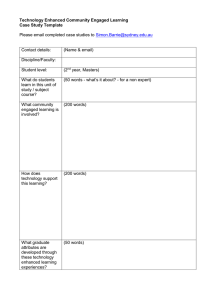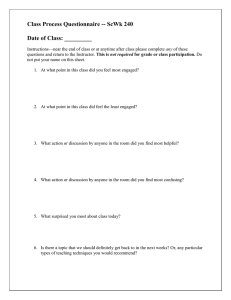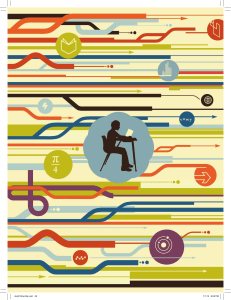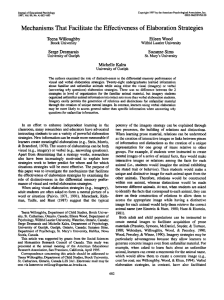Element of the Week—Element 26: Managing Response Rates
advertisement
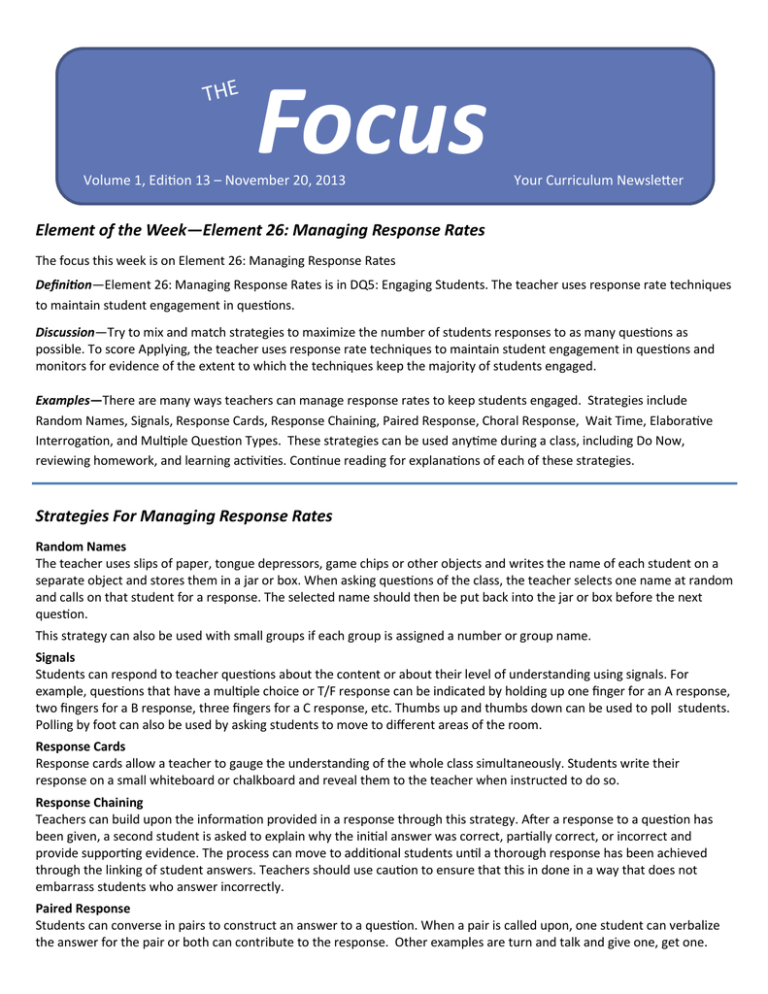
THE Focus Volume 1, Edition 13 – November 20, 2013 Your Curriculum Newsletter Element of the Week—Element 26: Managing Response Rates The focus this week is on Element 26: Managing Response Rates Definition—Element 26: Managing Response Rates is in DQ5: Engaging Students. The teacher uses response rate techniques to maintain student engagement in questions. Discussion—Try to mix and match strategies to maximize the number of students responses to as many questions as possible. To score Applying, the teacher uses response rate techniques to maintain student engagement in questions and monitors for evidence of the extent to which the techniques keep the majority of students engaged. Examples—There are many ways teachers can manage response rates to keep students engaged. Strategies include Random Names, Signals, Response Cards, Response Chaining, Paired Response, Choral Response, Wait Time, Elaborative Interrogation, and Multiple Question Types. These strategies can be used anytime during a class, including Do Now, reviewing homework, and learning activities. Continue reading for explanations of each of these strategies. Strategies For Managing Response Rates Random Names The teacher uses slips of paper, tongue depressors, game chips or other objects and writes the name of each student on a separate object and stores them in a jar or box. When asking questions of the class, the teacher selects one name at random and calls on that student for a response. The selected name should then be put back into the jar or box before the next question. This strategy can also be used with small groups if each group is assigned a number or group name. Signals Students can respond to teacher questions about the content or about their level of understanding using signals. For example, questions that have a multiple choice or T/F response can be indicated by holding up one finger for an A response, two fingers for a B response, three fingers for a C response, etc. Thumbs up and thumbs down can be used to poll students. Polling by foot can also be used by asking students to move to different areas of the room. Response Cards Response cards allow a teacher to gauge the understanding of the whole class simultaneously. Students write their response on a small whiteboard or chalkboard and reveal them to the teacher when instructed to do so. Response Chaining Teachers can build upon the information provided in a response through this strategy. After a response to a question has been given, a second student is asked to explain why the initial answer was correct, partially correct, or incorrect and provide supporting evidence. The process can move to additional students until a thorough response has been achieved through the linking of student answers. Teachers should use caution to ensure that this in done in a way that does not embarrass students who answer incorrectly. Paired Response Students can converse in pairs to construct an answer to a question. When a pair is called upon, one student can verbalize the answer for the pair or both can contribute to the response. Other examples are turn and talk and give one, get one. Choral Response This strategy calls for the teacher to provide students with targeted information and then have them repeat it as a group. This reinforces key knowledge and provides a method of “imprinting” information that students may find difficult. Wait Time Giving students time to reflect on the questions and responses given during discussions allows them to process ideas more fully. Teachers should utilize a three second pause in each of the following scenarios: • After posing a question and prior to calling on a responder • After an answer has been provided and prior to other students responding When a student pauses while giving an answer or asking a question. Have students write answers first. Don’t call on the first student that raises their hand. Elaborative Interrogation When a student has provided an answer to a question, probe his or her response with a follow-up question that requires them to provide supporting evidence (i.e., How do you know that is true?, Why is that so?). Be careful not to frustrate. Change strategies as needed. Multiple Question Types Vary the type of questions used in class to include all of the following: • Retrieval Questions – require students to recognize, recall, and execute knowledge that was directly taught • Analytical Questions – require students to take information apart and determine how the parts relate to the whole • Predictive Questions – require students to hypothesize about what will happen next in a narrative or sequence of information or actions • Interpretive Questions – require students to make and defend inferences Evaluative Questions – require students to use criteria to make judgments about something The ultimate goal of managing response rates is for the entire class to be engaged and process the content being probed by the teacher. Using question/answer strategies helps keep the learning energy high and students focused in their working memories in order to process and deepen understanding of concepts, skills, and strategies. The Focus is a collaborative effort between the Office of the Assistant Superintendent/ Elementary and the Curriculum Office. Assistant Superintendent/Elementary Anthony Petruzzelli Director of Curriculum Stan Krzyminski Content-Area Supervisors Debbie Droke—Mathematics, BSI Laura Gore—English Language Arts, BSI Dean Insana—Special Areas
